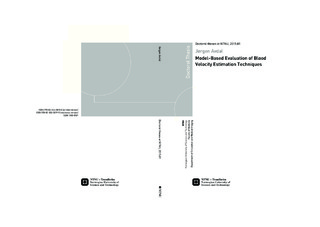| dc.contributor.author | Avdal, Jørgen | |
| dc.date.accessioned | 2015-05-15T07:25:45Z | |
| dc.date.available | 2015-05-15T07:25:45Z | |
| dc.date.issued | 2015 | |
| dc.identifier.isbn | 978-82-326-0818-8 | |
| dc.identifier.isbn | 978-82-326-0819-5 | |
| dc.identifier.issn | 1503-8181 | |
| dc.identifier.uri | http://hdl.handle.net/11250/283616 | |
| dc.description.abstract | Pulsed Wave (PW) Doppler is a flow imaging modality in which the velocity distribution of the blood flow in a spatial region is displayed over time. In this work, methods for improvement of the conventional PW Doppler technique are evaluated using mathemathical models, in vitro and in vivo studies. The first part of the thesis is an evaluation of the use of sparse sequences for simultaneous PW Doppler and Bmode imaging, the second part investigates properties of the recently proposed 2-D Tracking Doppler method, and in particular the feasibility of this method for cardiac applications.
In conventional PW Doppler/B-mode duplex ultrasound, packets of B-mode and Doppler transmissions are interleaved, producing undesirable gaps in the Doppler data. In this context, several sparse sequence methods have been proposed in which PW Doppler spectra are generated from observation windows containing missing samples. In this work we show that sparse sequence methods have two signi cant weaknesses. Firstly, it is shown that long reverberation times lead to discontinuities in the signal from stationary clutter after each B-mode interruption. Secondly, using frequency analysis, it is shown that clutter ltering of non-uniformly sampled data may introduce artifacts in the velocity spectrum. Methods are presented for quanti cation of these effects, and their severity in clinical applications are shown using in vivo examples.
Two-dimensional (2-D) tracking Doppler is a proposed alternative to PW Doppler, in which the sample volume follows the trajectory of the blood scatterers over time. Compared to PW Doppler, 2-D tracking Doppler has longer observation time of individual scatterers and therefore reduced transit time broadening. An extensive signal model is presented and is, in addition to in vitro and in vivo recordings, used to evaluate properties of the 2-D tracking Doppler technique. It is shown that the spectra have lowest bandwidth and maximum power when the tracking angle is equal
to the beam-to-flow angle, which may be used for automatic angle correction. In vitro studies and simulations indicate that automatic angle correction using tracking Doppler may be more accurate than manual angle correction, especially for high beam to-flow angles.
The feasibility of using 2-D tracking Doppler for maximum velocity estimation in
cardiac jet flow was investigated using simulations, in vitro and in vivo recordings. The results indicate that the -6 dB relative broadening of tracking Doppler spectra is smaller than 5% for tracking angles up to 80 , and also that the maximum power is found when tracking in the flow direction. | nb_NO |
| dc.language.iso | eng | nb_NO |
| dc.publisher | NTNU | nb_NO |
| dc.relation.ispartofseries | Doctoral thesis at NTNU;2015:81 | |
| dc.relation.haspart | Paper 1:
Avdal, Jørgen; Løvstakken, Lasse; Torp, Hans.
Effects of reverberations and clutter filtering in pulsed Doppler using sparse sequences. IEEE Transactions on Ultrasonics, Ferroelectrics and Frequency Control 2015 ;Volum 62.(5) s. 828-838
http://dx.doi.org/10.1109/TUFFC.2014.006798
© 2015 IEEE. Personal use of this material is permitted. Permission from IEEE must be obtained for all other uses, in any current or future media, including reprinting/republishing this material for advertising or promotional purposes, creating new collective works, for resale or redistribution to servers or lists, or reuse of any copyrighted component of this work in other works. | |
| dc.relation.haspart | Paper 2:
Fredriksen, Tonje Dobrowen; Avdal, Jørgen; Ekroll, Ingvild Kinn; Dahl, Torbjørn; Løvstakken, Lasse; Torp, Hans.
Investigations of spectral resolution and angle dependency in a 2-D tracking doppler method. IEEE Transactions on Ultrasonics, Ferroelectrics and Frequency Control 2014 ;Volum 61.(7) s. 1161-1170
http://dx.doi.org/10.1109/TUFFC.2014.3015
© 2014 IEEE. Personal use of this material is permitted. Permission from IEEE must be obtained for all other uses, in any current or future media, including reprinting/republishing this material for advertising or promotional purposes, creating new collective works, for resale or redistribution to servers or lists, or reuse of any copyrighted component of this work in other works. | |
| dc.relation.haspart | Paper 3:
Avdal, Jørgen; Ekroll, Ingvild Kinn; Fadnes, Solveig; Løvstakken, Lasse; Torp, Hans.
2D tracking doppler for cardiac jet flow velocity estimation. IEEE International Ultrasonics Symposium Proceedings 2014 s. 1718-1721
http://dx.doi.org/ 10.1109/ULTSYM.2014.0426
© 2014 IEEE. Personal use of this material is permitted. Permission from IEEE must be obtained for all other uses, in any current or future media, including reprinting/republishing this material for advertising or promotional purposes, creating new collective works, for resale or redistribution to servers or lists, or reuse of any copyrighted component of this work in other works. | |
| dc.relation.haspart | | |
| dc.title | Model-Based Evaluation of Blood Velocity Estimation Techniques | nb_NO |
| dc.type | Doctoral thesis | nb_NO |
| dc.subject.nsi | VDP::Medical disciplines: 700 | nb_NO |
